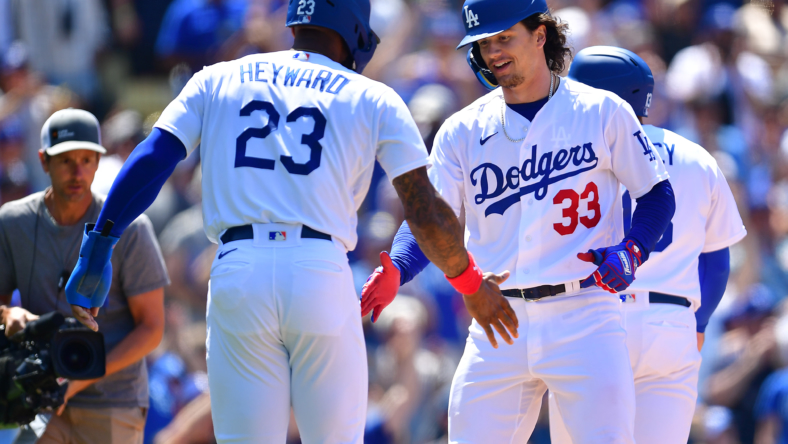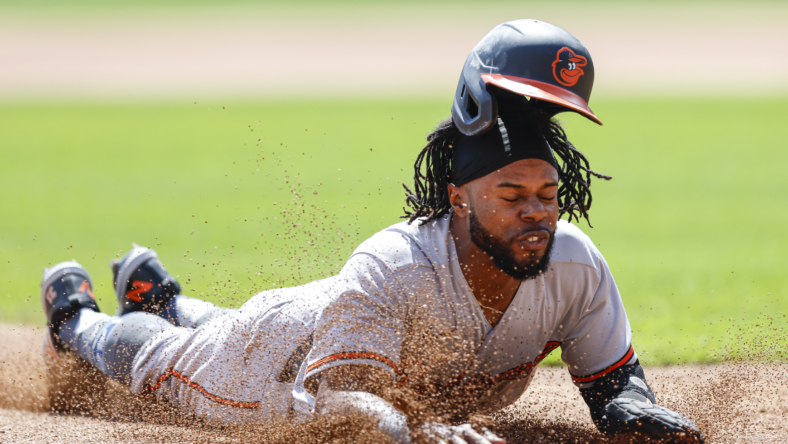
Everybody’s stealing more bases. Attempts are up across MLB by nearly one third since last year — successful steals by nearly 40 percent. The Cleveland Guardians are virtually unstoppable when they take off. And good luck trying to catch Baltimore Orioles teammates Cedric Mullins and Jorge Mateo.
So obviously the new MLB rules are working, incentivizing more action on the (larger) bases between the pitcher timer, pickoff-throw limits and that 4 1/2-inch reduction between the bases. Right?
No so fast.
Nobody doubts the rules are helping the results, but players and managers say their decisions to run have more to do with traditional game conditions and opportunity, or happenstance of personnel — or even just out of necessity because of shortcomings in other offensive areas.
Bottom line: The pitch timer might make the pace of games feel more like the 1970s or 80s, but the new rules impacting base running aren’t a threat to resurrect the likes of Vince Coleman or Rickey Henderson anytime soon.
Especially if speedy new Philadelphia Phillies shortstop Trea Turner was your pick to usher in a new age of old-time MLB base-stealing numbers.
“It’s definitely not as easy as I thought it would be,” Turner said. “But I also didn’t think that everyone was just going to have 80 stolen bases individually, either. Like I didn’t think that whoever led the league last year, Jon Berti, was going to gain 20 bases.
“But it has been a little bit harder than I thought.”
Years of conditioning is part of it; it’s hard to break strategic habits based on generations of norms when the norms suddenly change. Do I really feel comfortable with that extra foot of a lead because the pitcher already has picked over twice?
Heightening that level of natural caution is how some teams combat runners from taking full advantage of the new MLB offensive rules. During a game in April, Milwaukee Brewers pitcher Corbin Burnes had runners at first and third with two outs, and when the count went full — knowing the runners would be going — he let the pitch clock wind down to one second, then whirled to second and caught the runner in no-man’s land for the inning-ending out.
“You’ve got to be smart,” Baltimore Orioles shortstop Jorge Mateo said.
Other MLB factors slowing stolen bases

Home runs so far this season up 8.3 percent from last year, and we haven’t even reached the prime, warm-weather, homer-hitting time of the MLB season. The pitch clock also has created more big innings early in the season because a pitcher who loses mechanics or touch for a batter or two doesn’t have time to regroup before it becomes a four- or five-batter problem, players and managers say.
Those are factors that naturally make it less likely to chance the risk of taking the extra 90 feet or even to need it.
So are the new MLB rules actually compelling the extra action, as they were designed to do? Or are they merely facilitating action that already was intended?
“It’s a combination of both,” said Chicago Cubs second baseman Nico Hoerner, who spent much of April leading the National League in steals, after what he calls an important second half last year in improving that part of his game.
“Definitely the rules changes help,” he said. “But I think we would have continued to be aggressive regardless.”
The Los Angeles Dodgers, for instance are in the bottom third of the National League in steals and attempts, in large part because they’re in the top three in the majors in home runs. And also because not very many of them run fast.
“We have the ability to slug more than other teams. Other teams have the ability to steal bases more frequently more successfully than we do,” Dodgers manager Dave Roberts said. “We haven’t been good as far as percentage-wise. And I’m not inclined to run just because of teams run. I still don’t like giving up outs or giving away bases.”
Baltimore Orioles staying on the run

Other MLB teams would be teams such as the Orioles.
Mateo, the man who led the American League with 35 steals a year ago, perked up quickly during some downtime before a recent game when asked how many bases he could steal this year with the new rules in effect.
“I don’t know, but it’s going to be a lot,” Mateo said. “It’s going to be fun.
“We’re ready. Every pitch. Taking advantage every time, to steal a base.”
Through Wednesday Mateo was 14-for-16 in steal attempts. Teammate Cedric Mullins, 13-for-14.
Consequently, the Orioles rank fifth in baseball in steals and second to only the Cleveland Guardians (85.1%) in success rate at 83%.
The Guardians need as many extra 90-foot doses of offense as they can get to score. They hit home runs less often than anyone else in baseball and are among the three lowest scoring teams.
“So we just try to create,” Guardians shortstop Amad Rosario said, “like with men on first, on a base hit to right we move first to third in that situation. We just try to take advantage [of each opportunity].
Said Straw: “We just look to stay aggressive. I feel that’s just kind of the team we are. With the MLB rule change or not, I feel like that’s kind of our style of play.”
The Orioles, on the other hand, have a balanced enough lineup to be able to do a lot of things well enough to mix and match and pick at other teams’ run prevention weaknesses.
“If you look at the top of our stolen bases, it’s Mullins and Mateo. And new rules or not new rules, we’re always going to try to get those guys 30-40 stolen bases,” manager Brandon Hyde said. “The majority of our stolen bases have nothing to do with the new rules. It hasn’t been because of the timing, the clock, or that people are picking over less.
“We picked good times to run. And we’re athletic with team speed; and we’re pretty young.”
Exhibit A: In the season opener against slow-to-the-plate Corey Kluber and the Boston Red Sox, the O’s went 5-for-5 in steals, including two each by Mullins and Mateo.
Exhibit B: In the second game of the season, against slower-to-the-plate Chris Sale, the O’s went 5-for-5 again, with two more by Mateo and another by Mullins.
Take those out of the equation, and the Orioles are a more mundane 36-for-44 in 47 games since.
“I kind of agree with the Orioles,” Turner said of the uptick vs. the incentives, “in the sense of it might not necessarily have to do with the rules. Lessening the pickoffs has been nice. That’s the most important one of the bunch. I don’t think the pitch clock or the bigger bases have had as big of an impact as people thought they would.
“Obviously, it’s still early,” he added. “We’ll see how it plays out.”
Gordon Wittenmyer covers Major League Baseball for Sportsnaut. You can follow him on Twitter at @GDubCub.